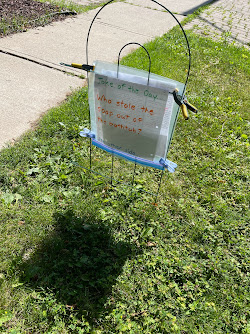 |
This Dundas homeowner replaced their front grass with wildflowers and native perennials. Lots of people stop to chat about the change and compliment them on how it looks. |
I noticed an increased number of people purposefully seeking to engage the public over the pandemic. The first sign of people coming together was the 7 pm nationwide initiative to head out front and bang pots and pans to show appreciation for healthcare and other frontline workers. Another example is the increased number of Little Free Libraries appearing at the edge of people's front yards. These give-a-book, take-a-book exchanges have been around since 2009 but grew in popularity — more so in the second year of the pandemic after the initial hyper-cautiousness about Covid had diminished — as a way to build community and spread good will. According to the Little Free Library website, the structures are intended as mini-town-squares that help residents meet, and make neighbourhoods feel friendlier. In addition, according to a Los Angeles Times article, residents have been using their existing libraries or building similar units, like "Blessing Boxes," to share non-perishables and pandemic supplies like hand sanitizer or toilet paper.
 |
| Amid the pandemic seriousness, one creative Dundas homeowner gave neighbours a daily guffaw by posting a riddle at the edge of her front yard. |
James Howard Kunstler points out the bias that privileges indoor over outdoor life, and in particular the disappearance of a useful front porch, in his Atlantic article, Home from Nowhere, which examines the crisis of urban sprawl and supports New Urbanism principles to bring back human-scaled public spaces. In the article, Kunstler says,
Likewise, the front porch is an important and desirable element in some neighborhoods. A porch less than six feet deep is useless except for storage, because it provides too little room for furniture and the circulation of human bodies. Builders tack on inadequate porches as a sales gimmick to enhance "curb appeal," so that the real-estate agent can drive up with the customer and say, "Look, a front porch!" The porch becomes a cartoon feature of the house, like the little fake cupola on the garage. This saves the builders money in time and materials. Perhaps they assume that the street will be too repulsive to sit next to.Why do builders even bother with pathetic-looking cartoon porches? Apparently Americans need at least the idea of a porch to be reassured, symbolically, that they're decent people living in a decent place. But the cartoon porch only compounds the degradation of the public realm.
The need for human interaction is so basic, perhaps we take it for granted; but the truth is creating spaces that facilitate social behaviour is not necessarily easy or a priority for architects. Jan Gehl is a pioneering Danish urban planner who observes that it is "inherently human to want to be around other people, that being in the presence of other people is highly interesting, and we should build our cities accordingly — at the human scale" (listen to Gehl discuss his urban planning philosophy on SPACE10 Design Lab's Imagine podcast). For his more than 50-year career, Gehl has focussed on creating spaces that are "good for people." Gehl describes his architectural education as preoccupied with interior spaces:
Everything I was taught in architecture school was about life inside buildings. It was always believed that by changing the inside of buildings, people could have a better life. Then we started to think, maybe ‘good for people’ is not inside the buildings, but also outside the buildings. Maybe, ‘good for people’ is very much what is happening between the buildings and not in the buildings themselves.
* Desire paths are unintended trails or walkways that emerge naturally, usually skirting the formal paths installed by indifferent officials. A sitting area created by the homeowner in the front yard is a type of spacial desire path that addresses an unfulfilled need intuitively and creatively. Listen to the wonderful 99% Invisible podcast discuss desire paths.







No comments:
Post a Comment